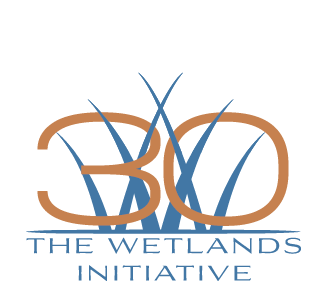The plan was exciting: Wetlands Initiative ecologists would host biology students from Brookfield Zoo’s master’s degree program at both the Dixon Waterfowl Refuge and Midewin National Tallgrass Prairie to learn hands-on about wetland and prairie ecosystems and their restoration. But like many of 2020’s well-laid plans, it took considerable adjustment for TWI ecologists Dr. Gary Sullivan and Anna Braum to lead the virtual equivalent of these field classes via Zoom.
In partnership with Miami University in Ohio, the Brookfield Zoo Master’s Degree Advanced Inquiry Program (AIP) combines conservation-focused, experiential learning at the zoo with an online master’s program in biology or teaching in biological sciences. For the summer 2020 course “Regional Ecology: Biodiversity in Northern Illinois,” Brookfield Zoo’s Agnes Kovacs had invited TWI to lead two daylong field classes. After the COVID-19 pandemic struck, Agnes asked Gary and Anna if the classes could go virtual.
TWI Senior Ecologist Gary Sullivan presenting on Midewin restoration to Brookfield Zoo master’s students via Zoom.
TWI provided ecology readings that students were to complete before the classes. For their online teaching, Gary and Anna used photos, videos, and drone footage from the Dixon Refuge and Midewin, where TWI has years of restoration experience to draw on, and they incorporated polls and breakout discussions to make the experience more interactive for the students. Gary took on prairies and Anna covered wetlands, each filling a full three hours over two days.
“I cannot say enough wonderful things about how Gary and Anna led the two days of ‘Regional Ecology,’” said Agnes, who is the senior manager of graduate programs and partnerships at Brookfield Zoo. “And the information they shared was perfect. They gave up-to-date information on wetlands and prairies as well as foundational content on the nature and need for both of these resources. They were amazing!”
The 28 students had a wide variety of backgrounds, including grade-school teachers, veterinary technicians, plant nursery employees, and more. At the end of his class, Gary asked them to consider a somewhat philosophical question: “With so much prairie already lost in Illinois (99.99%), why should we work so hard to conserve or restore the rest?” After splitting into small discussion groups on Zoom, the students returned with a range of responses, from preserving ecosystem services like biodiversity support, carbon sequestration, and flood control to maintaining human quality of life and the natural heritage of the Prairie State for future generations.
Anna gave a pop quiz at the beginning of her class and asked the students to vote on which of six photos are wetland habitats. It turns out that all but one are a type of wetland, though they look very different from one another and don’t necessarily look like a stereotypical marsh where standing water is visible.
Anna’s pop quiz at the beginning of her class: Which of these photos show a wetland? (Scroll to the end of the article for the answers.)
“It took some thought to translate what would have primarily been a learning experience in the field into a virtual format,” said Anna. “We brainstormed engaging elements for a presentation that would be three hours long and entirely online. It was fun discussing the nuts and bolts of wetland restoration and introducing the diversity of wetland habitats at the Dixon Refuge to this enthusiastic group of students.”
With so many activities going remote in 2020, these virtual classes are just one way TWI staff are continuing to share their passion and expertise. Hopefully TWI will be invited by Brookfield Zoo to teach them again—next time in person and in the field!
Answers to Anna’s pop quiz: They’re all wetlands except E! A is a sedge meadow (photo by Gary Sullivan/TWI), B is a wet prairie (photo by Rachel Goad), C is a fen (photo by Scott Namestnik), D is a marsh (photo by Gary Sullivan/TWI), E is a mesic prairie (photo by Joshua Mayer), and F is a panne (photo by Anna Braum/TWI).

